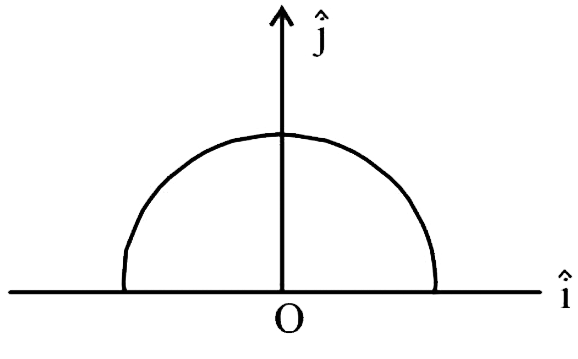The radius of a gold nucleus (Z=79) is about 7.0⋅10−10m. Assume that the positive charge is distributed uniformly throughout the the nuclear volume. Find the strength of the electric field at (a) the surface of the nucleus and (b) at the middle point of a radius. Remembering that gold is a conductor, is it justified to assume that the positive charge is uniformly distributed over the entire volume of the nucleus and does not come to the outer surface?
To solve the problem, we will calculate the electric field at the surface of the gold nucleus and at the midpoint of its radius using Gauss's Law.
Given Data:
- Atomic number of gold (Z) = 79
- Charge of a proton (e) = 1.6×10−19C
- Radius of the gold nucleus (R) = 7.0×10−10m
Step 1: Calculate the total charge of the gold nucleus
The total charge Q of the nucleus can be calculated using the formula:
Q=Z⋅e
Substituting the values:
Q=79⋅(1.6×10−19)=1.264×10−17C
Step 2: Electric field at the surface of the nucleus
Using Gauss's Law, the electric field E at the surface of a uniformly charged sphere is given by:
E=Q4πϵ0R2
Where ϵ0=8.85×10−12C2/N m2.
Substituting the values:
E=1.264×10−174π(8.85×10−12)(7.0×10−10)2
Calculating R2:
R2=(7.0×10−10)2=4.9×10−19m2
Now substituting R2 into the equation:
E=1.264×10−174π(8.85×10−12)(4.9×10−19)
Calculating the denominator:
4π(8.85×10−12)(4.9×10−19)≈5.45×10−30
Now calculating E:
E≈1.264×10−175.45×10−30≈2.32×1012N/C
Step 3: Electric field at the midpoint of the radius
At a point inside a uniformly charged sphere, the electric field E is given by:
E=Q4πϵ0R3r
Where r is the distance from the center to the midpoint of the radius:
r=R2=7.0×10−102=3.5×10−10m
Now substituting r into the equation:
E=Q4πϵ0R3⋅(R2)
This simplifies to:
E=Q8πϵ0R2
Substituting the values:
E=1.264×10−178π(8.85×10−12)(4.9×10−19)
Calculating the denominator:
8π(8.85×10−12)(4.9×10−19)≈1.09×10−29
Now calculating E:
E≈1.264×10−171.09×10−29≈1.16×1012N/C
Conclusion:
- Electric field at the surface of the nucleus: E≈2.32×1012N/C
- Electric field at the midpoint of the radius: E≈1.16×1012N/C
Justification of Charge Distribution:
It is justified to assume that the positive charge is uniformly distributed throughout the entire volume of the nucleus because, in a conductor, charges redistribute themselves to maintain electrostatic equilibrium. However, in the case of a nucleus, it is treated as a uniform distribution due to the strong nuclear forces acting within it, which keeps the protons closely packed.
- Atomic number of gold (Z) = 79
- Charge of a proton (e) = 1.6×10−19C
- Radius of the gold nucleus (R) = 7.0×10−10m
The total charge Q of the nucleus can be calculated using the formula:
Q=Z⋅e
Substituting the values:
Q=79⋅(1.6×10−19)=1.264×10−17C
Using Gauss's Law, the electric field E at the surface of a uniformly charged sphere is given by:
E=Q4πϵ0R2
Where ϵ0=8.85×10−12C2/N m2.
E=1.264×10−174π(8.85×10−12)(7.0×10−10)2
R2=(7.0×10−10)2=4.9×10−19m2
E=1.264×10−174π(8.85×10−12)(4.9×10−19)
Calculating the denominator:
4π(8.85×10−12)(4.9×10−19)≈5.45×10−30
E≈1.264×10−175.45×10−30≈2.32×1012N/C
At a point inside a uniformly charged sphere, the electric field E is given by:
E=Q4πϵ0R3r
Where r is the distance from the center to the midpoint of the radius:
r=R2=7.0×10−102=3.5×10−10m
E=Q4πϵ0R3⋅(R2)
This simplifies to:
E=Q8πϵ0R2
E=1.264×10−178π(8.85×10−12)(4.9×10−19)
8π(8.85×10−12)(4.9×10−19)≈1.09×10−29
E≈1.264×10−171.09×10−29≈1.16×1012N/C
- Electric field at the surface of the nucleus: E≈2.32×1012N/C
- Electric field at the midpoint of the radius: E≈1.16×1012N/C
It is justified to assume that the positive charge is uniformly distributed throughout the entire volume of the nucleus because, in a conductor, charges redistribute themselves to maintain electrostatic equilibrium. However, in the case of a nucleus, it is treated as a uniform distribution due to the strong nuclear forces acting within it, which keeps the protons closely packed.
Topper's Solved these Questions
- BOOK - HC VERMA ENGLISHCHAPTER - GAUSS LAWEXERCISE - Short Question7videos
GAUSS LAW
- BOOK - HC VERMA ENGLISHCHAPTER - GAUSS LAWEXERCISE - Objective 28videos
GAUSS LAW
- BOOK - HC VERMA ENGLISHCHAPTER - ELECTROMAGNETIC WAVESEXERCISE - Exercise8videos
ELECTROMAGNETIC WAVES
- BOOK - HC VERMA ENGLISHCHAPTER - GEOMETRICAL OPTICSEXERCISE - Question For short Answer18videos
GEOMETRICAL OPTICS
Similar Questions
A rubber balloon is given a charge Q distributed uniformly over its surface. Then
View SolutionFind the electric field at an arbitrary point of a sphere carrying a charge uniformly distributed over its volume.
View SolutionA 10 cm long rod carries a charge of +150μC distributed uniformly along its length. Find the magnitude of the electric field at a point 10 cm from both the ends of the rod.
View SolutionCalculate electric field due to a charge uniformly distributed in a spherical volume
View SolutionCharge q is uniformly distributed over a thin half ring of radius R. The electric field at the centre of the ring is
View SolutionA wire of length l and charge q is bent in form of a semicircle. The charge is uniformly distributed over the length. The electric field at the centre of semicircle is
View SolutionA charge q is uniformly distributed over a quarter circular ring of radius r. The magnitude of electric field strength at the centre of the ring will be
View SolutionA ring of radius a contains a charge q distributed. uniformly ober its length. Find the electric field at a point. on the axis of the ring at a distance x from the centre.
View SolutionA sphere carries a uniformly distributed electric charge. Prove that the field inside the sphere is zero
View SolutionA thin semi-circular ring of radius r has a positive charge q distributed uniformly over it. The net field →E at the centre O is
 View Solution
View Solution

